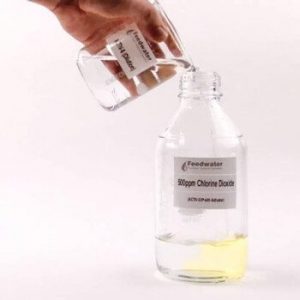Why is Chlorine Dioxide so good?
 Chlorine Dioxide has been called the ideal biocide because of its unique combination of properties.
Chlorine Dioxide has been called the ideal biocide because of its unique combination of properties.Potency – It is extremely effective at low dosages. Maintaining a continuous free residual of just 0.1 – 0.5 mg/l of ClO2 in a water supply has been shown to be effective in controlling a wide range of harmful bacteria and problematic microbes.
Rapid kill – Chlorine dioxide disinfects and sanitises in seconds, where other microbiocides can take many hours or even days to work.
Not pH sensitive – Unlike chlorine and bromine, which both become less effective as the pH of water rises, ClO2 remains an extremely effective biocide between pH 4 and 10.
Effective biocide against biofilms – Because chlorine dioxide is a readily soluble gas which dissolves in water without forming ionic species, it is able to permeate and penetrate biofilms which are often relatively resistant to other disinfectants and biocides, such as chlorine. This makes ClO2 particularly effective in controlling and removing pseudomonas and other slime-forming bacteria which can cause major problems in systems such as cooling towers, heat exchangers, spa pools/baths and hot tubs.
Potency against legionella – Chlorine dioxide is extremely effective disinfectant used for legionella control and inhibiting the microbial biofilms in which they tend to grow. It is recognised as an effective biocide and disinfectant to control the risk of Legionnaires’ Disease associated with hot and cold domestic water systems, cooling water systems, spa baths, hot tubs and leisure pools.
No Halogenated Disinfection By-Products (DBPs) -When chlorine dosing systems are used in the purification of drinking water that contains natural organic compounds such as humic and fulvic acids, it tends to form halogenated disinfection by-products such as tri-halo-methanes (THMs). Drinking water containing such DBPs has been shown to increase the risk of cancer. ClO2 works differently to chlorine; its action is one of pure oxidation rather than halogenation, so these halogenated DBPs are not formed.
High Selectivity – Whilst Chlorine Dioxide is an extremely powerful oxidant, it has a lower reduction potential than most other commonly used oxidising biocides and disinfectants. This lower redox potential means that it is able to kill the microbes without reacting with other contaminants, often resulting in much lower dosage rates which can make it the cheaper alternative.
No Taste, Odour and Taint Problems – Ordinary chlorine reacts with ammonium compounds to form environmentally damaging chloramines, which give the water an unpleasant taste and odour. Because chlorine dioxide doesn’t form chloramines and other halogenated DBPs, it does not cause taste and odour problems in drinking water, and in process water there is less risk of tainted product. This means ClO2 is often used in drinking water purification and is the disinfectant and sanitiser of choice for water used in food and beverage pr
No comments:
Post a Comment